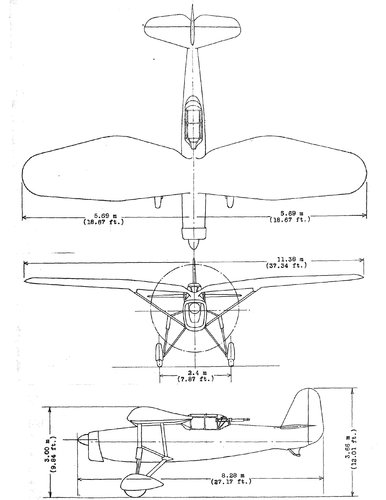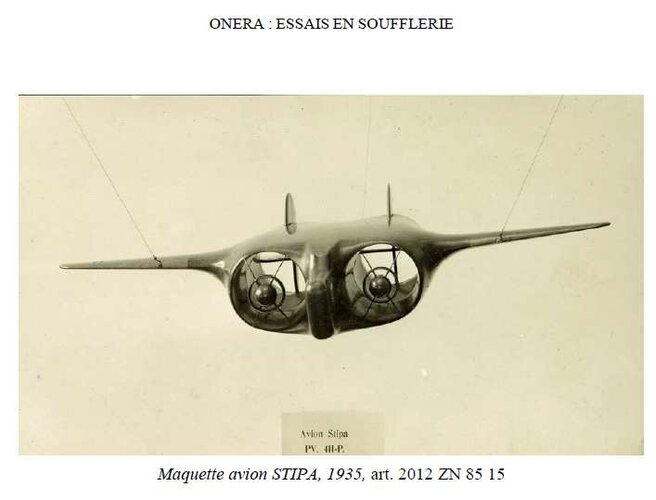Hi! ANF Les Mureaux 190.
Engine exhaust mozzles are located bottom of the nose of the aircraft.
I think also engine cooling air directed downward at bow chamber. Perhaps engine exhaust nozzles had jet pump(ejector) function to increase engine cooling air flow. Downward direction gas/air generate some lift. This lift generate pitch up moment. To cancel this pitch up moment, elevator must be generate some lift. So total lift increase and wing loading decrease to realize good maneuverability.
https://en.wikipedia.org/wiki/ANF_Les_Mureaux_190
"The ANF Les Mureaux 190 was a French prototype light fighter aircraft. In response to a program created by the French Minister of Air, the ANF Les Mureaux 190 was designed by André Brunet as a light fighter. The ANF Les Mureaux 190 was an all-metal monoplane, and was first tested in July 1936, then taken to the 15th Paris Air Show in late November, where it was asserted to be very manoeuvrable. However, less than a year later, the project was abandoned due to the poor quality of its engine.
The ANF Les Mureax 190 was powered by a 450 hp Salmson 12 Vars inverted V-12 engine. its proposed armament consisted of a 20 mm (0.79 in) engine-mounted cannon, and two 7.7mm (.30-caliber) wing-mounted machine guns.
General characteristics
Crew: 1
Length: 7.2 m (23 ft 7 in)
Wingspan: 8.38 m (27 ft 6 in)
Height: 3 m (9 ft 10 in)
Wing area: 10 m2 (110 sq ft)
Empty weight: 850 kg (1,874 lb)
Gross weight: 1,290 kg (2,844 lb)
Powerplant: 1 × Salmson 12 Vars 12-cylinder inverted-V air-cooled, 340 kW (450 hp)
Performance
Maximum speed: 500 km/h (311 mph; 270 kn)
Armament
Guns: 1×20mm cannon, 2×7.7mm machine guns
http://www.airwar.ru/enc/fww1/mureaux190.html
"In 1936, the production of the prototype was completed and the aircraft that had not yet flown was sent to Paris to participate in the annual air show. The first flights of the Mureaux 190 C1 were carried out in July 1936 under the supervision of the factory test pilot Dejober (Desjobert). During the factory tests it was found out that, despite the fact that the wing of the aircraft was equipped with flaps, a high specific load on the wing made the plane's behavior at low speeds quite complicated. However, in general, the maneuverability of the machine was good. In the wings with a thin high-speed profile, a very interesting technical solution was applied in the form of a powerful bow chamber, the design of which was patented by Brunet. Also during the tests, serious problems in the power plant were discovered: the engine suffered from various failures and overheating of the rear cylinders. As a result, the aircraft repeatedly returned to the company's workshops, where it spent more time than at the airport.
Although the prototype was not installed during the tests, after their completion it was planned to equip the plane with a 20-mm Hispano 404 gun for firing through a hollow screw bushing and two 7.7-mm MAC 34 machine guns, one in each wing console. In the model designed for series production, the installation of the Salmson 12 engine was provided, capable of developing a power of 750 hp. (551 kW), but the development of this engine stalled.
Due to constant problems, the management of ANF-Mureaux decided that the prototype 190 C1 was to become a sort of flying laboratory and a demonstrator of technologies. The battle warrant was to be the 191 C1, equipped with a powerful 750-horsepower Salmson 12 engine, a set of weapons and retractable main landing gear racks.
Work on the production of the glider 191 C1 began in 1937. Thus, the official tests of the 190 C1 were completed, and the aircraft itself, designed to test a more powerful engine, was sent to storage.
In 1938, Salmson's management announced that further work on the development of a powerful twelve-cylinder engine was completed, and the very issue of creating a 750-horsepower engine was closed. This meant the end of the 191 C1 project, since redesigning it for the installation of another engine actually meant the development of a new aircraft. Radial engines required a major overhaul, and as for the Renault company, which was part of the Caudron-Renault association and also developed in-line air-cooled engines, its management tried not to supply competitors with its engines.
It should be said that the command of the French Air Force gradually lost interest in light fighters, and by 1939 these types of aircraft were no longer among those with high priority. The prototype ANF-Mureaux 190 C1 survived the war, after the capitulation was written off.
In conclusion, it should be said that from the technical point of view, the 190 C1 was continued. After nationalization, Potez, in addition to ANF-Mureaux, joined the SNCAN with its powerful plants and design office. André Brunet, together with his new colleagues Lemaître and Hubert, developed the "featherweight" Potez 230 C1 fighter, which used a series of junctions of the unfinished ANF-Mureaux 191 C1 (a wing with retractable main landing gear racks, tail fins and part of the fuselage ). With a liquid-cooled engine Hispano-Suiza 12 Xcrs (630 hp [493 kW]), the Potez 230 C1 prototype was launched in March 1940. Serial production of Potez 230 C1 was not ordered and after the defeat of France the aircraft was taken to Germany to study the design of the wing."
So Potez 230 initial design wing plan form was similar to Mureaux 190?












































